Strategic Alliance in International Business: A Case Study Report
VerifiedAdded on 2022/11/23
|13
|4056
|223
Report
AI Summary
This report examines international strategic alliances, focusing on the partnership between Virgin Atlantic and Delta Airlines. It begins with an executive summary and an introduction to international business and globalization, highlighting the role of strategic alliances in foreign market expansion. A literature review explores the use of these alliances, motivations behind their formation, and benefits. The report then delves into the specific alliance between Virgin Atlantic and Delta Airlines, analyzing the motivations, benefits, and challenges for both partners. It also considers alternative market entry strategies. The report concludes with a discussion of the advantages and disadvantages of strategic alliances in the context of international business and provides a comprehensive analysis of the chosen case study, supported by relevant literature and research.

International business
Paraphrase This Document
Need a fresh take? Get an instant paraphrase of this document with our AI Paraphraser
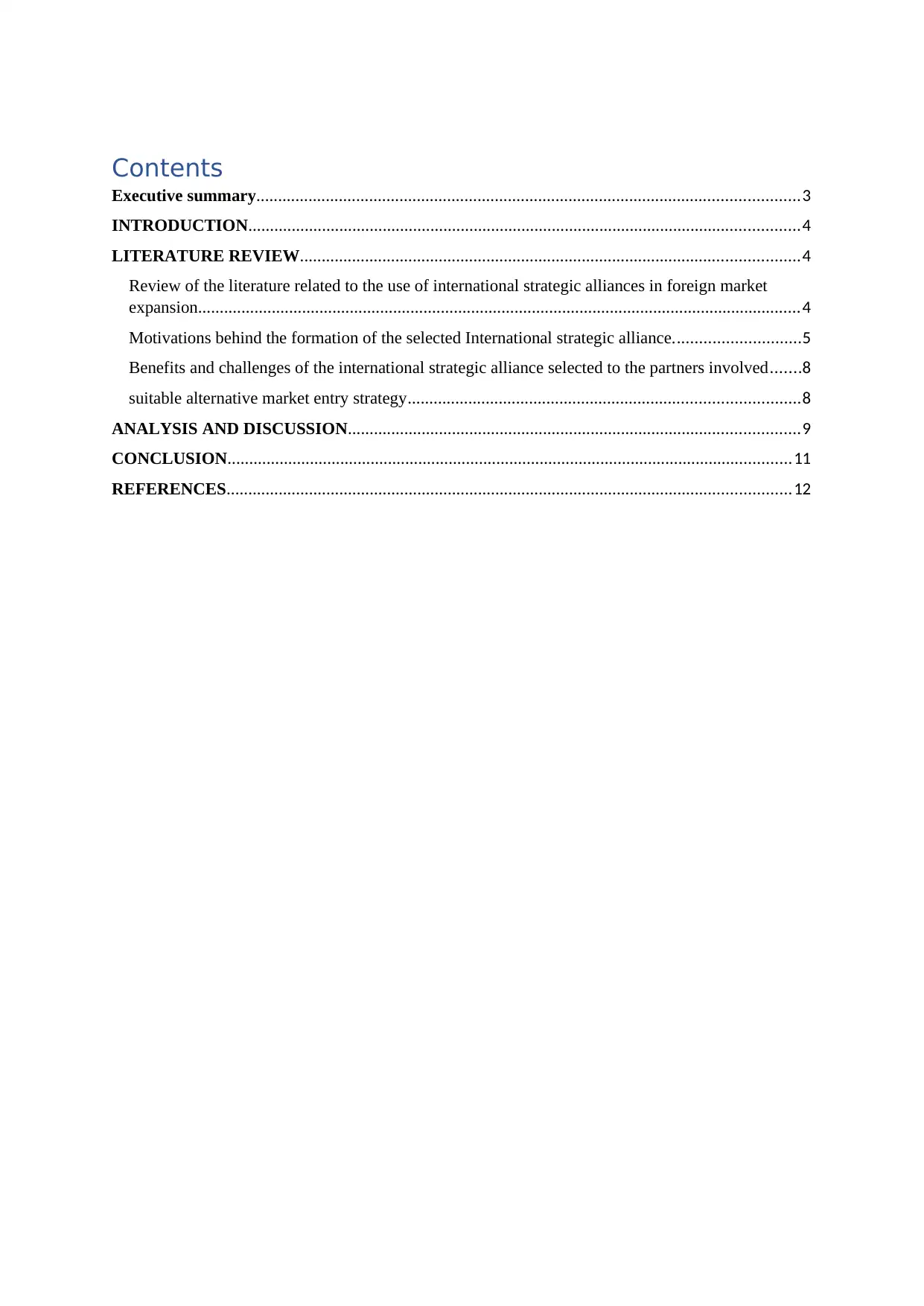
Contents
Executive summary.............................................................................................................................3
INTRODUCTION...............................................................................................................................4
LITERATURE REVIEW...................................................................................................................4
Review of the literature related to the use of international strategic alliances in foreign market
expansion...........................................................................................................................................4
Motivations behind the formation of the selected International strategic alliance.............................5
Benefits and challenges of the international strategic alliance selected to the partners involved.......8
suitable alternative market entry strategy..........................................................................................8
ANALYSIS AND DISCUSSION........................................................................................................9
CONCLUSION..................................................................................................................................11
REFERENCES..................................................................................................................................12
Executive summary.............................................................................................................................3
INTRODUCTION...............................................................................................................................4
LITERATURE REVIEW...................................................................................................................4
Review of the literature related to the use of international strategic alliances in foreign market
expansion...........................................................................................................................................4
Motivations behind the formation of the selected International strategic alliance.............................5
Benefits and challenges of the international strategic alliance selected to the partners involved.......8
suitable alternative market entry strategy..........................................................................................8
ANALYSIS AND DISCUSSION........................................................................................................9
CONCLUSION..................................................................................................................................11
REFERENCES..................................................................................................................................12
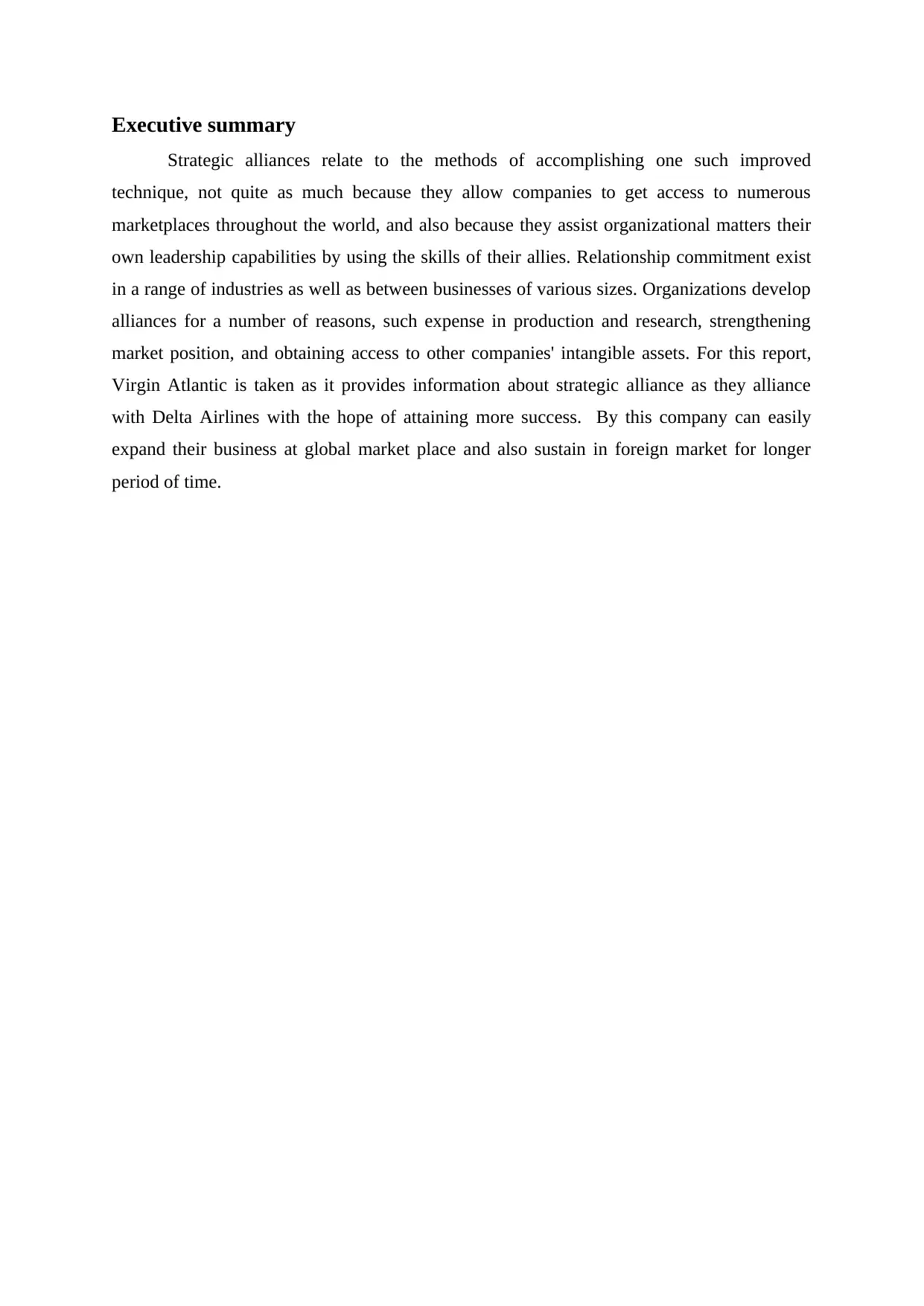
Executive summary
Strategic alliances relate to the methods of accomplishing one such improved
technique, not quite as much because they allow companies to get access to numerous
marketplaces throughout the world, and also because they assist organizational matters their
own leadership capabilities by using the skills of their allies. Relationship commitment exist
in a range of industries as well as between businesses of various sizes. Organizations develop
alliances for a number of reasons, such expense in production and research, strengthening
market position, and obtaining access to other companies' intangible assets. For this report,
Virgin Atlantic is taken as it provides information about strategic alliance as they alliance
with Delta Airlines with the hope of attaining more success. By this company can easily
expand their business at global market place and also sustain in foreign market for longer
period of time.
Strategic alliances relate to the methods of accomplishing one such improved
technique, not quite as much because they allow companies to get access to numerous
marketplaces throughout the world, and also because they assist organizational matters their
own leadership capabilities by using the skills of their allies. Relationship commitment exist
in a range of industries as well as between businesses of various sizes. Organizations develop
alliances for a number of reasons, such expense in production and research, strengthening
market position, and obtaining access to other companies' intangible assets. For this report,
Virgin Atlantic is taken as it provides information about strategic alliance as they alliance
with Delta Airlines with the hope of attaining more success. By this company can easily
expand their business at global market place and also sustain in foreign market for longer
period of time.
⊘ This is a preview!⊘
Do you want full access?
Subscribe today to unlock all pages.

Trusted by 1+ million students worldwide
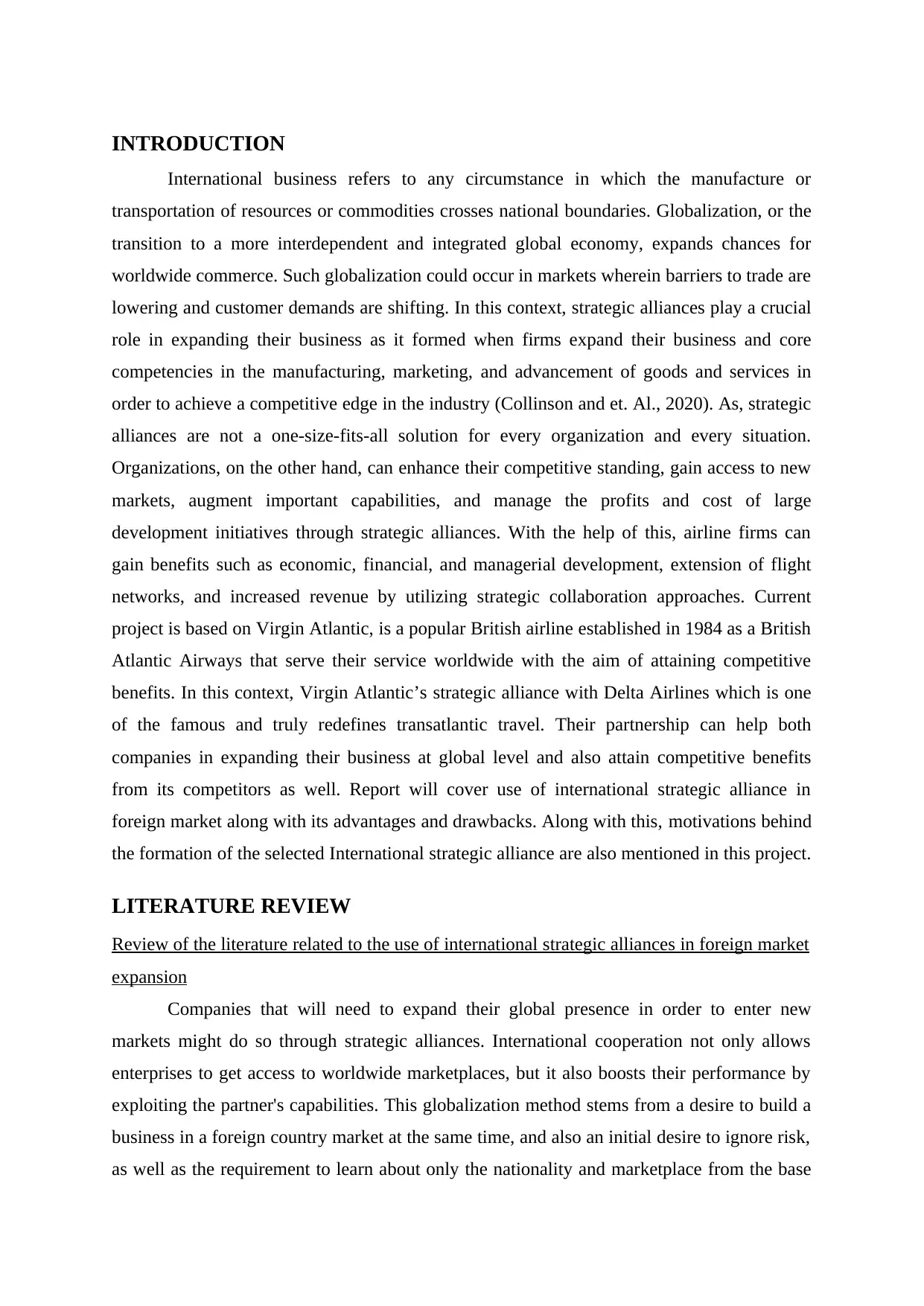
INTRODUCTION
International business refers to any circumstance in which the manufacture or
transportation of resources or commodities crosses national boundaries. Globalization, or the
transition to a more interdependent and integrated global economy, expands chances for
worldwide commerce. Such globalization could occur in markets wherein barriers to trade are
lowering and customer demands are shifting. In this context, strategic alliances play a crucial
role in expanding their business as it formed when firms expand their business and core
competencies in the manufacturing, marketing, and advancement of goods and services in
order to achieve a competitive edge in the industry (Collinson and et. Al., 2020). As, strategic
alliances are not a one-size-fits-all solution for every organization and every situation.
Organizations, on the other hand, can enhance their competitive standing, gain access to new
markets, augment important capabilities, and manage the profits and cost of large
development initiatives through strategic alliances. With the help of this, airline firms can
gain benefits such as economic, financial, and managerial development, extension of flight
networks, and increased revenue by utilizing strategic collaboration approaches. Current
project is based on Virgin Atlantic, is a popular British airline established in 1984 as a British
Atlantic Airways that serve their service worldwide with the aim of attaining competitive
benefits. In this context, Virgin Atlantic’s strategic alliance with Delta Airlines which is one
of the famous and truly redefines transatlantic travel. Their partnership can help both
companies in expanding their business at global level and also attain competitive benefits
from its competitors as well. Report will cover use of international strategic alliance in
foreign market along with its advantages and drawbacks. Along with this, motivations behind
the formation of the selected International strategic alliance are also mentioned in this project.
LITERATURE REVIEW
Review of the literature related to the use of international strategic alliances in foreign market
expansion
Companies that will need to expand their global presence in order to enter new
markets might do so through strategic alliances. International cooperation not only allows
enterprises to get access to worldwide marketplaces, but it also boosts their performance by
exploiting the partner's capabilities. This globalization method stems from a desire to build a
business in a foreign country market at the same time, and also an initial desire to ignore risk,
as well as the requirement to learn about only the nationality and marketplace from the base
International business refers to any circumstance in which the manufacture or
transportation of resources or commodities crosses national boundaries. Globalization, or the
transition to a more interdependent and integrated global economy, expands chances for
worldwide commerce. Such globalization could occur in markets wherein barriers to trade are
lowering and customer demands are shifting. In this context, strategic alliances play a crucial
role in expanding their business as it formed when firms expand their business and core
competencies in the manufacturing, marketing, and advancement of goods and services in
order to achieve a competitive edge in the industry (Collinson and et. Al., 2020). As, strategic
alliances are not a one-size-fits-all solution for every organization and every situation.
Organizations, on the other hand, can enhance their competitive standing, gain access to new
markets, augment important capabilities, and manage the profits and cost of large
development initiatives through strategic alliances. With the help of this, airline firms can
gain benefits such as economic, financial, and managerial development, extension of flight
networks, and increased revenue by utilizing strategic collaboration approaches. Current
project is based on Virgin Atlantic, is a popular British airline established in 1984 as a British
Atlantic Airways that serve their service worldwide with the aim of attaining competitive
benefits. In this context, Virgin Atlantic’s strategic alliance with Delta Airlines which is one
of the famous and truly redefines transatlantic travel. Their partnership can help both
companies in expanding their business at global level and also attain competitive benefits
from its competitors as well. Report will cover use of international strategic alliance in
foreign market along with its advantages and drawbacks. Along with this, motivations behind
the formation of the selected International strategic alliance are also mentioned in this project.
LITERATURE REVIEW
Review of the literature related to the use of international strategic alliances in foreign market
expansion
Companies that will need to expand their global presence in order to enter new
markets might do so through strategic alliances. International cooperation not only allows
enterprises to get access to worldwide marketplaces, but it also boosts their performance by
exploiting the partner's capabilities. This globalization method stems from a desire to build a
business in a foreign country market at the same time, and also an initial desire to ignore risk,
as well as the requirement to learn about only the nationality and marketplace from the base
Paraphrase This Document
Need a fresh take? Get an instant paraphrase of this document with our AI Paraphraser
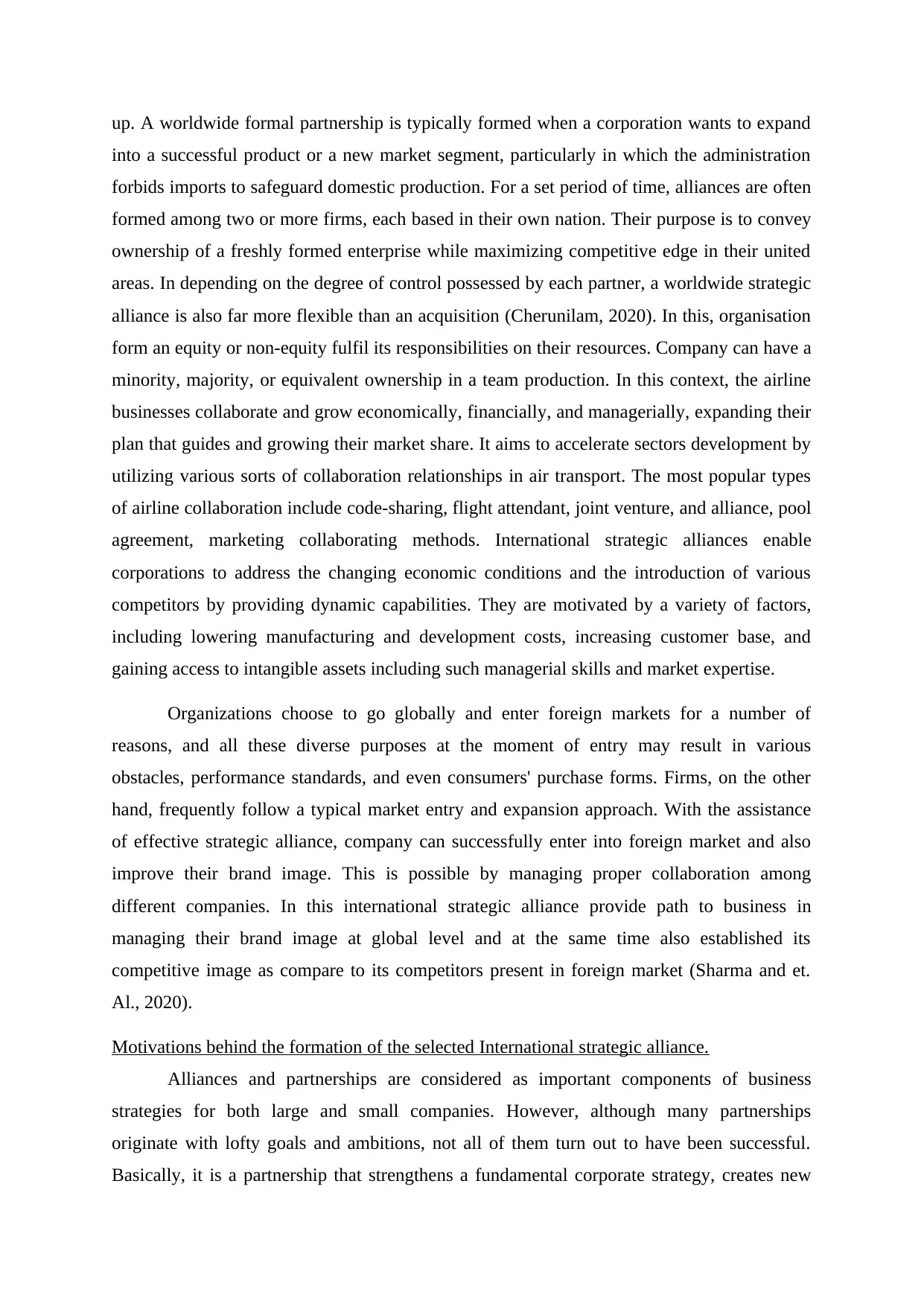
up. A worldwide formal partnership is typically formed when a corporation wants to expand
into a successful product or a new market segment, particularly in which the administration
forbids imports to safeguard domestic production. For a set period of time, alliances are often
formed among two or more firms, each based in their own nation. Their purpose is to convey
ownership of a freshly formed enterprise while maximizing competitive edge in their united
areas. In depending on the degree of control possessed by each partner, a worldwide strategic
alliance is also far more flexible than an acquisition (Cherunilam, 2020). In this, organisation
form an equity or non-equity fulfil its responsibilities on their resources. Company can have a
minority, majority, or equivalent ownership in a team production. In this context, the airline
businesses collaborate and grow economically, financially, and managerially, expanding their
plan that guides and growing their market share. It aims to accelerate sectors development by
utilizing various sorts of collaboration relationships in air transport. The most popular types
of airline collaboration include code-sharing, flight attendant, joint venture, and alliance, pool
agreement, marketing collaborating methods. International strategic alliances enable
corporations to address the changing economic conditions and the introduction of various
competitors by providing dynamic capabilities. They are motivated by a variety of factors,
including lowering manufacturing and development costs, increasing customer base, and
gaining access to intangible assets including such managerial skills and market expertise.
Organizations choose to go globally and enter foreign markets for a number of
reasons, and all these diverse purposes at the moment of entry may result in various
obstacles, performance standards, and even consumers' purchase forms. Firms, on the other
hand, frequently follow a typical market entry and expansion approach. With the assistance
of effective strategic alliance, company can successfully enter into foreign market and also
improve their brand image. This is possible by managing proper collaboration among
different companies. In this international strategic alliance provide path to business in
managing their brand image at global level and at the same time also established its
competitive image as compare to its competitors present in foreign market (Sharma and et.
Al., 2020).
Motivations behind the formation of the selected International strategic alliance.
Alliances and partnerships are considered as important components of business
strategies for both large and small companies. However, although many partnerships
originate with lofty goals and ambitions, not all of them turn out to have been successful.
Basically, it is a partnership that strengthens a fundamental corporate strategy, creates new
into a successful product or a new market segment, particularly in which the administration
forbids imports to safeguard domestic production. For a set period of time, alliances are often
formed among two or more firms, each based in their own nation. Their purpose is to convey
ownership of a freshly formed enterprise while maximizing competitive edge in their united
areas. In depending on the degree of control possessed by each partner, a worldwide strategic
alliance is also far more flexible than an acquisition (Cherunilam, 2020). In this, organisation
form an equity or non-equity fulfil its responsibilities on their resources. Company can have a
minority, majority, or equivalent ownership in a team production. In this context, the airline
businesses collaborate and grow economically, financially, and managerially, expanding their
plan that guides and growing their market share. It aims to accelerate sectors development by
utilizing various sorts of collaboration relationships in air transport. The most popular types
of airline collaboration include code-sharing, flight attendant, joint venture, and alliance, pool
agreement, marketing collaborating methods. International strategic alliances enable
corporations to address the changing economic conditions and the introduction of various
competitors by providing dynamic capabilities. They are motivated by a variety of factors,
including lowering manufacturing and development costs, increasing customer base, and
gaining access to intangible assets including such managerial skills and market expertise.
Organizations choose to go globally and enter foreign markets for a number of
reasons, and all these diverse purposes at the moment of entry may result in various
obstacles, performance standards, and even consumers' purchase forms. Firms, on the other
hand, frequently follow a typical market entry and expansion approach. With the assistance
of effective strategic alliance, company can successfully enter into foreign market and also
improve their brand image. This is possible by managing proper collaboration among
different companies. In this international strategic alliance provide path to business in
managing their brand image at global level and at the same time also established its
competitive image as compare to its competitors present in foreign market (Sharma and et.
Al., 2020).
Motivations behind the formation of the selected International strategic alliance.
Alliances and partnerships are considered as important components of business
strategies for both large and small companies. However, although many partnerships
originate with lofty goals and ambitions, not all of them turn out to have been successful.
Basically, it is a partnership that strengthens a fundamental corporate strategy, creates new
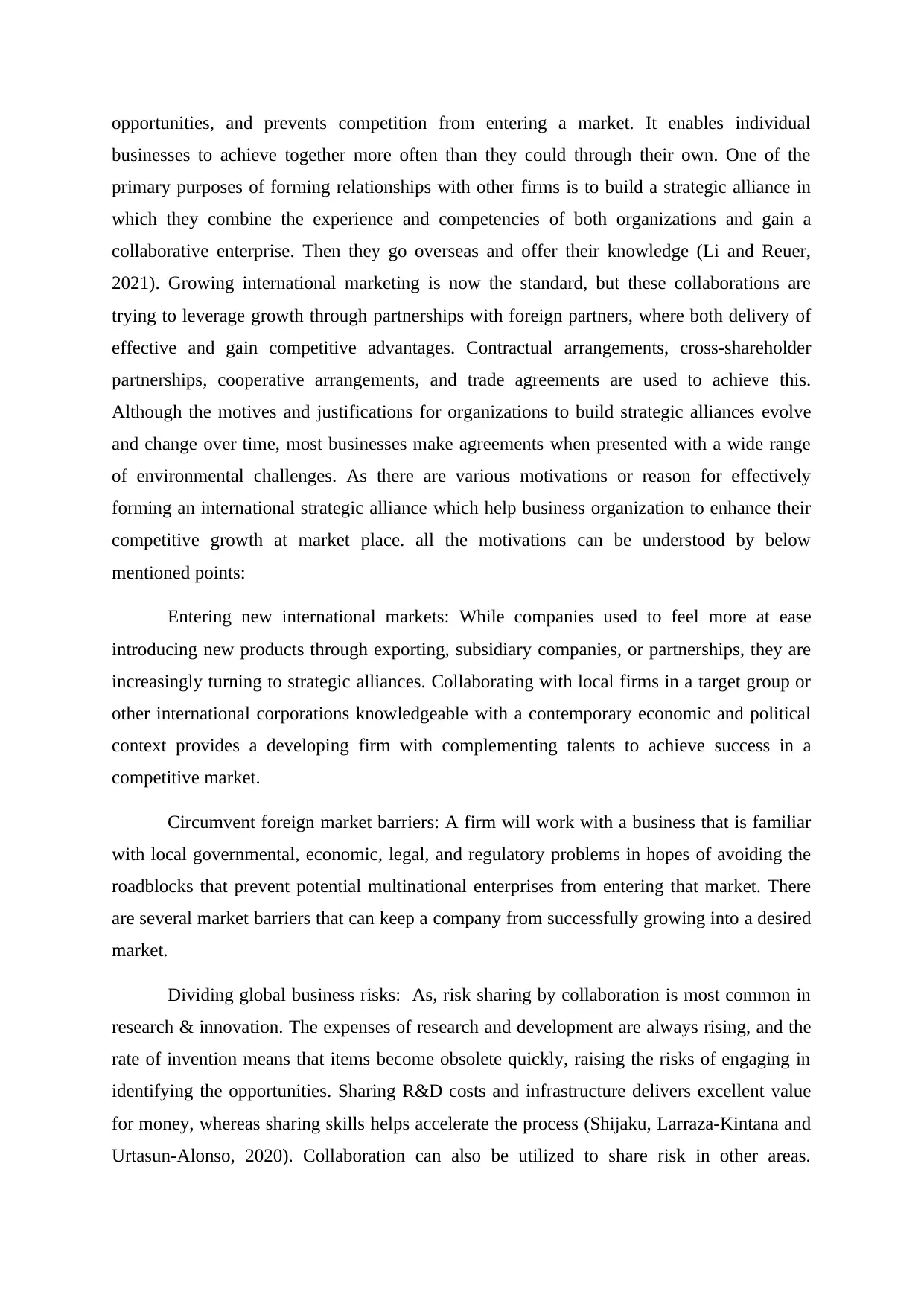
opportunities, and prevents competition from entering a market. It enables individual
businesses to achieve together more often than they could through their own. One of the
primary purposes of forming relationships with other firms is to build a strategic alliance in
which they combine the experience and competencies of both organizations and gain a
collaborative enterprise. Then they go overseas and offer their knowledge (Li and Reuer,
2021). Growing international marketing is now the standard, but these collaborations are
trying to leverage growth through partnerships with foreign partners, where both delivery of
effective and gain competitive advantages. Contractual arrangements, cross-shareholder
partnerships, cooperative arrangements, and trade agreements are used to achieve this.
Although the motives and justifications for organizations to build strategic alliances evolve
and change over time, most businesses make agreements when presented with a wide range
of environmental challenges. As there are various motivations or reason for effectively
forming an international strategic alliance which help business organization to enhance their
competitive growth at market place. all the motivations can be understood by below
mentioned points:
Entering new international markets: While companies used to feel more at ease
introducing new products through exporting, subsidiary companies, or partnerships, they are
increasingly turning to strategic alliances. Collaborating with local firms in a target group or
other international corporations knowledgeable with a contemporary economic and political
context provides a developing firm with complementing talents to achieve success in a
competitive market.
Circumvent foreign market barriers: A firm will work with a business that is familiar
with local governmental, economic, legal, and regulatory problems in hopes of avoiding the
roadblocks that prevent potential multinational enterprises from entering that market. There
are several market barriers that can keep a company from successfully growing into a desired
market.
Dividing global business risks: As, risk sharing by collaboration is most common in
research & innovation. The expenses of research and development are always rising, and the
rate of invention means that items become obsolete quickly, raising the risks of engaging in
identifying the opportunities. Sharing R&D costs and infrastructure delivers excellent value
for money, whereas sharing skills helps accelerate the process (Shijaku, Larraza-Kintana and
Urtasun-Alonso, 2020). Collaboration can also be utilized to share risk in other areas.
businesses to achieve together more often than they could through their own. One of the
primary purposes of forming relationships with other firms is to build a strategic alliance in
which they combine the experience and competencies of both organizations and gain a
collaborative enterprise. Then they go overseas and offer their knowledge (Li and Reuer,
2021). Growing international marketing is now the standard, but these collaborations are
trying to leverage growth through partnerships with foreign partners, where both delivery of
effective and gain competitive advantages. Contractual arrangements, cross-shareholder
partnerships, cooperative arrangements, and trade agreements are used to achieve this.
Although the motives and justifications for organizations to build strategic alliances evolve
and change over time, most businesses make agreements when presented with a wide range
of environmental challenges. As there are various motivations or reason for effectively
forming an international strategic alliance which help business organization to enhance their
competitive growth at market place. all the motivations can be understood by below
mentioned points:
Entering new international markets: While companies used to feel more at ease
introducing new products through exporting, subsidiary companies, or partnerships, they are
increasingly turning to strategic alliances. Collaborating with local firms in a target group or
other international corporations knowledgeable with a contemporary economic and political
context provides a developing firm with complementing talents to achieve success in a
competitive market.
Circumvent foreign market barriers: A firm will work with a business that is familiar
with local governmental, economic, legal, and regulatory problems in hopes of avoiding the
roadblocks that prevent potential multinational enterprises from entering that market. There
are several market barriers that can keep a company from successfully growing into a desired
market.
Dividing global business risks: As, risk sharing by collaboration is most common in
research & innovation. The expenses of research and development are always rising, and the
rate of invention means that items become obsolete quickly, raising the risks of engaging in
identifying the opportunities. Sharing R&D costs and infrastructure delivers excellent value
for money, whereas sharing skills helps accelerate the process (Shijaku, Larraza-Kintana and
Urtasun-Alonso, 2020). Collaboration can also be utilized to share risk in other areas.
⊘ This is a preview!⊘
Do you want full access?
Subscribe today to unlock all pages.

Trusted by 1+ million students worldwide
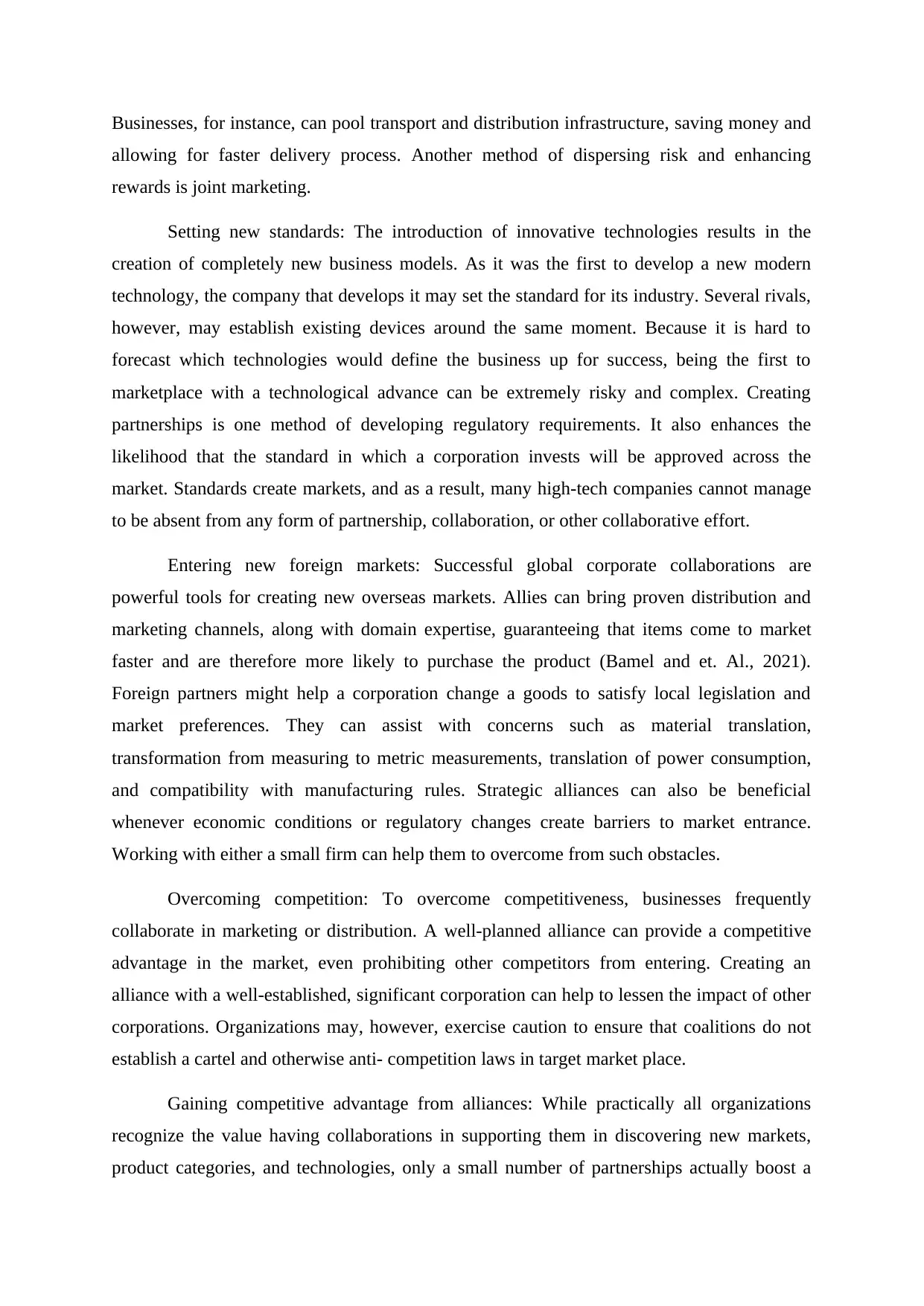
Businesses, for instance, can pool transport and distribution infrastructure, saving money and
allowing for faster delivery process. Another method of dispersing risk and enhancing
rewards is joint marketing.
Setting new standards: The introduction of innovative technologies results in the
creation of completely new business models. As it was the first to develop a new modern
technology, the company that develops it may set the standard for its industry. Several rivals,
however, may establish existing devices around the same moment. Because it is hard to
forecast which technologies would define the business up for success, being the first to
marketplace with a technological advance can be extremely risky and complex. Creating
partnerships is one method of developing regulatory requirements. It also enhances the
likelihood that the standard in which a corporation invests will be approved across the
market. Standards create markets, and as a result, many high-tech companies cannot manage
to be absent from any form of partnership, collaboration, or other collaborative effort.
Entering new foreign markets: Successful global corporate collaborations are
powerful tools for creating new overseas markets. Allies can bring proven distribution and
marketing channels, along with domain expertise, guaranteeing that items come to market
faster and are therefore more likely to purchase the product (Bamel and et. Al., 2021).
Foreign partners might help a corporation change a goods to satisfy local legislation and
market preferences. They can assist with concerns such as material translation,
transformation from measuring to metric measurements, translation of power consumption,
and compatibility with manufacturing rules. Strategic alliances can also be beneficial
whenever economic conditions or regulatory changes create barriers to market entrance.
Working with either a small firm can help them to overcome from such obstacles.
Overcoming competition: To overcome competitiveness, businesses frequently
collaborate in marketing or distribution. A well-planned alliance can provide a competitive
advantage in the market, even prohibiting other competitors from entering. Creating an
alliance with a well-established, significant corporation can help to lessen the impact of other
corporations. Organizations may, however, exercise caution to ensure that coalitions do not
establish a cartel and otherwise anti- competition laws in target market place.
Gaining competitive advantage from alliances: While practically all organizations
recognize the value having collaborations in supporting them in discovering new markets,
product categories, and technologies, only a small number of partnerships actually boost a
allowing for faster delivery process. Another method of dispersing risk and enhancing
rewards is joint marketing.
Setting new standards: The introduction of innovative technologies results in the
creation of completely new business models. As it was the first to develop a new modern
technology, the company that develops it may set the standard for its industry. Several rivals,
however, may establish existing devices around the same moment. Because it is hard to
forecast which technologies would define the business up for success, being the first to
marketplace with a technological advance can be extremely risky and complex. Creating
partnerships is one method of developing regulatory requirements. It also enhances the
likelihood that the standard in which a corporation invests will be approved across the
market. Standards create markets, and as a result, many high-tech companies cannot manage
to be absent from any form of partnership, collaboration, or other collaborative effort.
Entering new foreign markets: Successful global corporate collaborations are
powerful tools for creating new overseas markets. Allies can bring proven distribution and
marketing channels, along with domain expertise, guaranteeing that items come to market
faster and are therefore more likely to purchase the product (Bamel and et. Al., 2021).
Foreign partners might help a corporation change a goods to satisfy local legislation and
market preferences. They can assist with concerns such as material translation,
transformation from measuring to metric measurements, translation of power consumption,
and compatibility with manufacturing rules. Strategic alliances can also be beneficial
whenever economic conditions or regulatory changes create barriers to market entrance.
Working with either a small firm can help them to overcome from such obstacles.
Overcoming competition: To overcome competitiveness, businesses frequently
collaborate in marketing or distribution. A well-planned alliance can provide a competitive
advantage in the market, even prohibiting other competitors from entering. Creating an
alliance with a well-established, significant corporation can help to lessen the impact of other
corporations. Organizations may, however, exercise caution to ensure that coalitions do not
establish a cartel and otherwise anti- competition laws in target market place.
Gaining competitive advantage from alliances: While practically all organizations
recognize the value having collaborations in supporting them in discovering new markets,
product categories, and technologies, only a small number of partnerships actually boost a
Paraphrase This Document
Need a fresh take? Get an instant paraphrase of this document with our AI Paraphraser
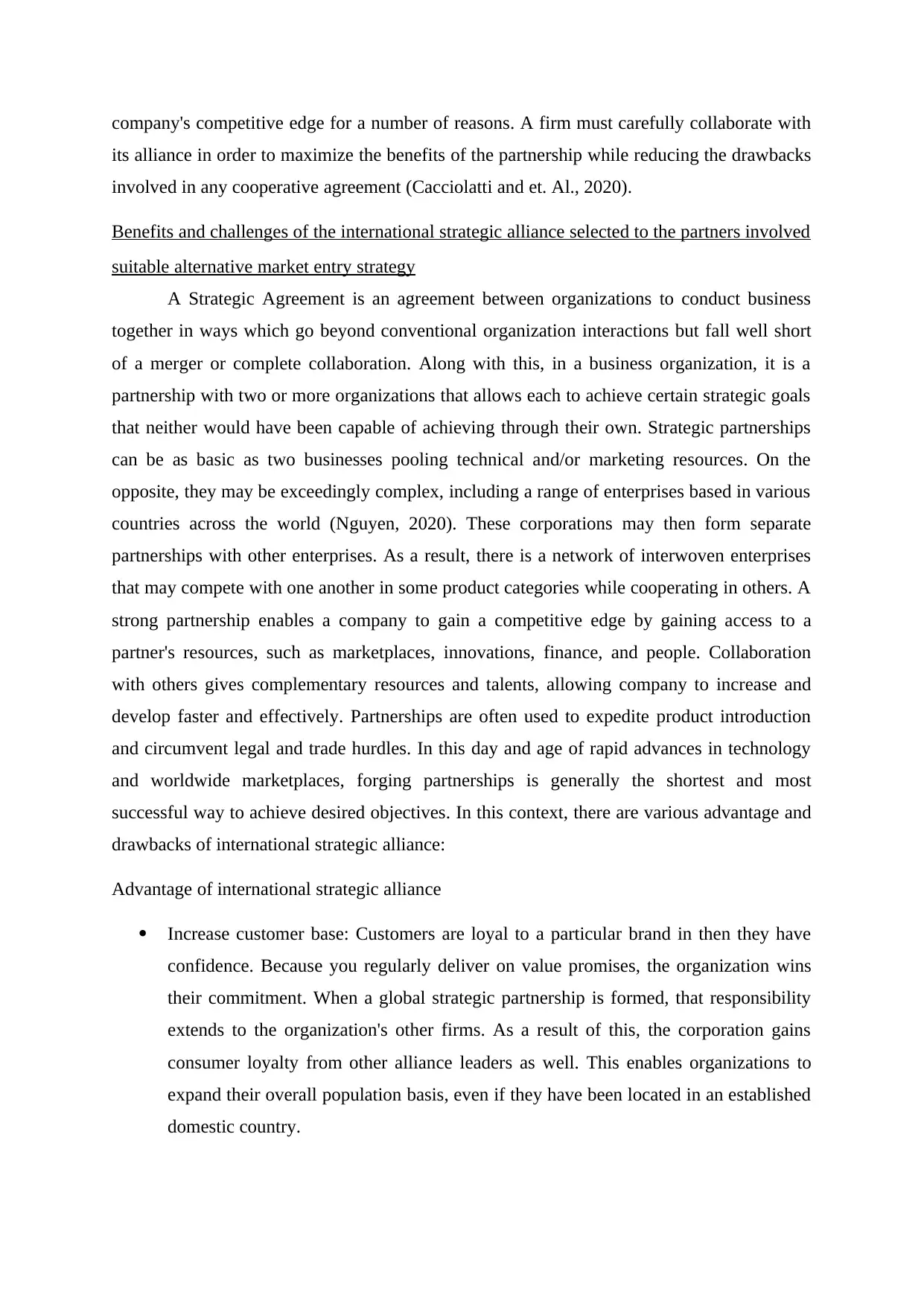
company's competitive edge for a number of reasons. A firm must carefully collaborate with
its alliance in order to maximize the benefits of the partnership while reducing the drawbacks
involved in any cooperative agreement (Cacciolatti and et. Al., 2020).
Benefits and challenges of the international strategic alliance selected to the partners involved
suitable alternative market entry strategy
A Strategic Agreement is an agreement between organizations to conduct business
together in ways which go beyond conventional organization interactions but fall well short
of a merger or complete collaboration. Along with this, in a business organization, it is a
partnership with two or more organizations that allows each to achieve certain strategic goals
that neither would have been capable of achieving through their own. Strategic partnerships
can be as basic as two businesses pooling technical and/or marketing resources. On the
opposite, they may be exceedingly complex, including a range of enterprises based in various
countries across the world (Nguyen, 2020). These corporations may then form separate
partnerships with other enterprises. As a result, there is a network of interwoven enterprises
that may compete with one another in some product categories while cooperating in others. A
strong partnership enables a company to gain a competitive edge by gaining access to a
partner's resources, such as marketplaces, innovations, finance, and people. Collaboration
with others gives complementary resources and talents, allowing company to increase and
develop faster and effectively. Partnerships are often used to expedite product introduction
and circumvent legal and trade hurdles. In this day and age of rapid advances in technology
and worldwide marketplaces, forging partnerships is generally the shortest and most
successful way to achieve desired objectives. In this context, there are various advantage and
drawbacks of international strategic alliance:
Advantage of international strategic alliance
Increase customer base: Customers are loyal to a particular brand in then they have
confidence. Because you regularly deliver on value promises, the organization wins
their commitment. When a global strategic partnership is formed, that responsibility
extends to the organization's other firms. As a result of this, the corporation gains
consumer loyalty from other alliance leaders as well. This enables organizations to
expand their overall population basis, even if they have been located in an established
domestic country.
its alliance in order to maximize the benefits of the partnership while reducing the drawbacks
involved in any cooperative agreement (Cacciolatti and et. Al., 2020).
Benefits and challenges of the international strategic alliance selected to the partners involved
suitable alternative market entry strategy
A Strategic Agreement is an agreement between organizations to conduct business
together in ways which go beyond conventional organization interactions but fall well short
of a merger or complete collaboration. Along with this, in a business organization, it is a
partnership with two or more organizations that allows each to achieve certain strategic goals
that neither would have been capable of achieving through their own. Strategic partnerships
can be as basic as two businesses pooling technical and/or marketing resources. On the
opposite, they may be exceedingly complex, including a range of enterprises based in various
countries across the world (Nguyen, 2020). These corporations may then form separate
partnerships with other enterprises. As a result, there is a network of interwoven enterprises
that may compete with one another in some product categories while cooperating in others. A
strong partnership enables a company to gain a competitive edge by gaining access to a
partner's resources, such as marketplaces, innovations, finance, and people. Collaboration
with others gives complementary resources and talents, allowing company to increase and
develop faster and effectively. Partnerships are often used to expedite product introduction
and circumvent legal and trade hurdles. In this day and age of rapid advances in technology
and worldwide marketplaces, forging partnerships is generally the shortest and most
successful way to achieve desired objectives. In this context, there are various advantage and
drawbacks of international strategic alliance:
Advantage of international strategic alliance
Increase customer base: Customers are loyal to a particular brand in then they have
confidence. Because you regularly deliver on value promises, the organization wins
their commitment. When a global strategic partnership is formed, that responsibility
extends to the organization's other firms. As a result of this, the corporation gains
consumer loyalty from other alliance leaders as well. This enables organizations to
expand their overall population basis, even if they have been located in an established
domestic country.
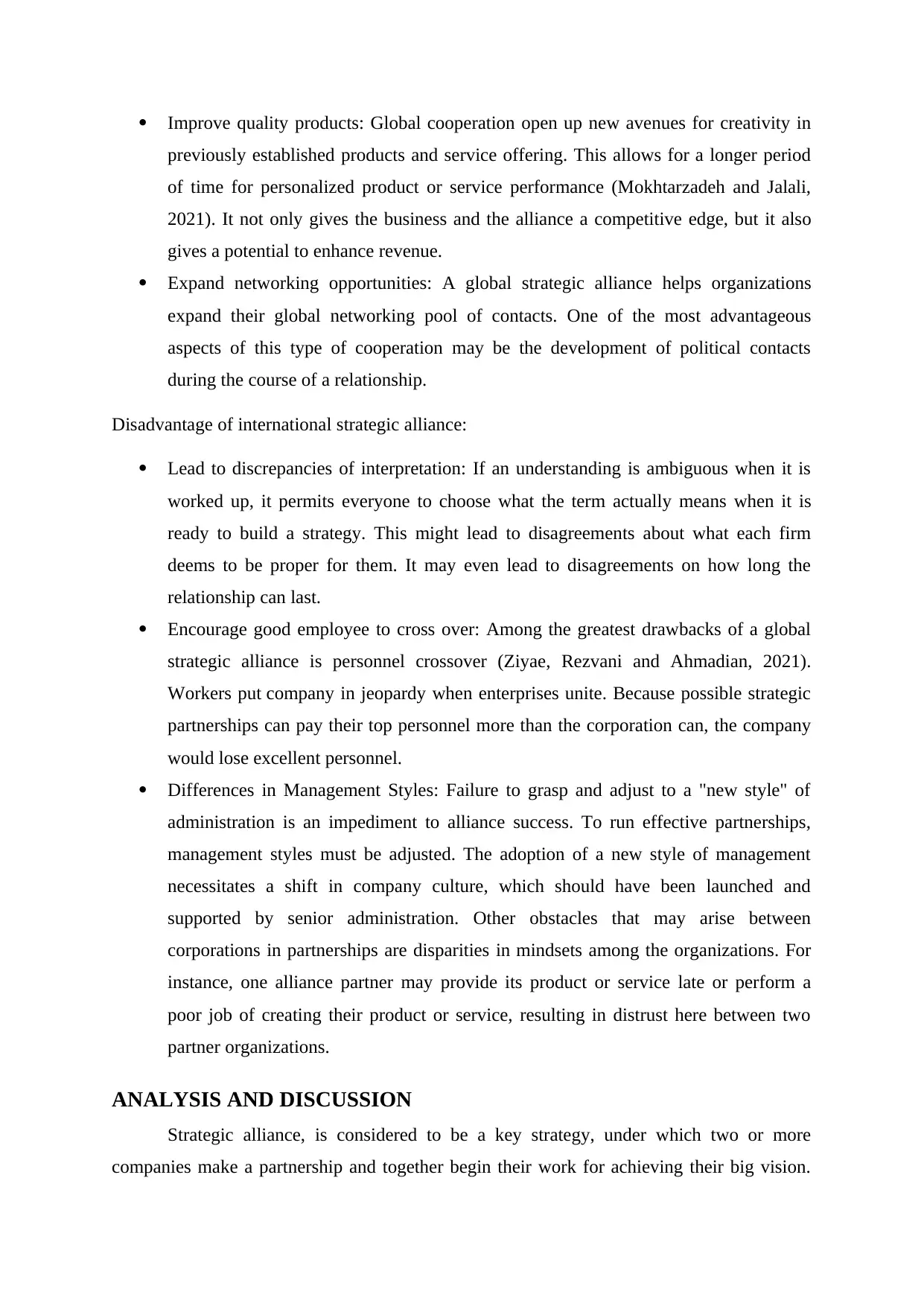
Improve quality products: Global cooperation open up new avenues for creativity in
previously established products and service offering. This allows for a longer period
of time for personalized product or service performance (Mokhtarzadeh and Jalali,
2021). It not only gives the business and the alliance a competitive edge, but it also
gives a potential to enhance revenue.
Expand networking opportunities: A global strategic alliance helps organizations
expand their global networking pool of contacts. One of the most advantageous
aspects of this type of cooperation may be the development of political contacts
during the course of a relationship.
Disadvantage of international strategic alliance:
Lead to discrepancies of interpretation: If an understanding is ambiguous when it is
worked up, it permits everyone to choose what the term actually means when it is
ready to build a strategy. This might lead to disagreements about what each firm
deems to be proper for them. It may even lead to disagreements on how long the
relationship can last.
Encourage good employee to cross over: Among the greatest drawbacks of a global
strategic alliance is personnel crossover (Ziyae, Rezvani and Ahmadian, 2021).
Workers put company in jeopardy when enterprises unite. Because possible strategic
partnerships can pay their top personnel more than the corporation can, the company
would lose excellent personnel.
Differences in Management Styles: Failure to grasp and adjust to a "new style" of
administration is an impediment to alliance success. To run effective partnerships,
management styles must be adjusted. The adoption of a new style of management
necessitates a shift in company culture, which should have been launched and
supported by senior administration. Other obstacles that may arise between
corporations in partnerships are disparities in mindsets among the organizations. For
instance, one alliance partner may provide its product or service late or perform a
poor job of creating their product or service, resulting in distrust here between two
partner organizations.
ANALYSIS AND DISCUSSION
Strategic alliance, is considered to be a key strategy, under which two or more
companies make a partnership and together begin their work for achieving their big vision.
previously established products and service offering. This allows for a longer period
of time for personalized product or service performance (Mokhtarzadeh and Jalali,
2021). It not only gives the business and the alliance a competitive edge, but it also
gives a potential to enhance revenue.
Expand networking opportunities: A global strategic alliance helps organizations
expand their global networking pool of contacts. One of the most advantageous
aspects of this type of cooperation may be the development of political contacts
during the course of a relationship.
Disadvantage of international strategic alliance:
Lead to discrepancies of interpretation: If an understanding is ambiguous when it is
worked up, it permits everyone to choose what the term actually means when it is
ready to build a strategy. This might lead to disagreements about what each firm
deems to be proper for them. It may even lead to disagreements on how long the
relationship can last.
Encourage good employee to cross over: Among the greatest drawbacks of a global
strategic alliance is personnel crossover (Ziyae, Rezvani and Ahmadian, 2021).
Workers put company in jeopardy when enterprises unite. Because possible strategic
partnerships can pay their top personnel more than the corporation can, the company
would lose excellent personnel.
Differences in Management Styles: Failure to grasp and adjust to a "new style" of
administration is an impediment to alliance success. To run effective partnerships,
management styles must be adjusted. The adoption of a new style of management
necessitates a shift in company culture, which should have been launched and
supported by senior administration. Other obstacles that may arise between
corporations in partnerships are disparities in mindsets among the organizations. For
instance, one alliance partner may provide its product or service late or perform a
poor job of creating their product or service, resulting in distrust here between two
partner organizations.
ANALYSIS AND DISCUSSION
Strategic alliance, is considered to be a key strategy, under which two or more
companies make a partnership and together begin their work for achieving their big vision.
⊘ This is a preview!⊘
Do you want full access?
Subscribe today to unlock all pages.

Trusted by 1+ million students worldwide
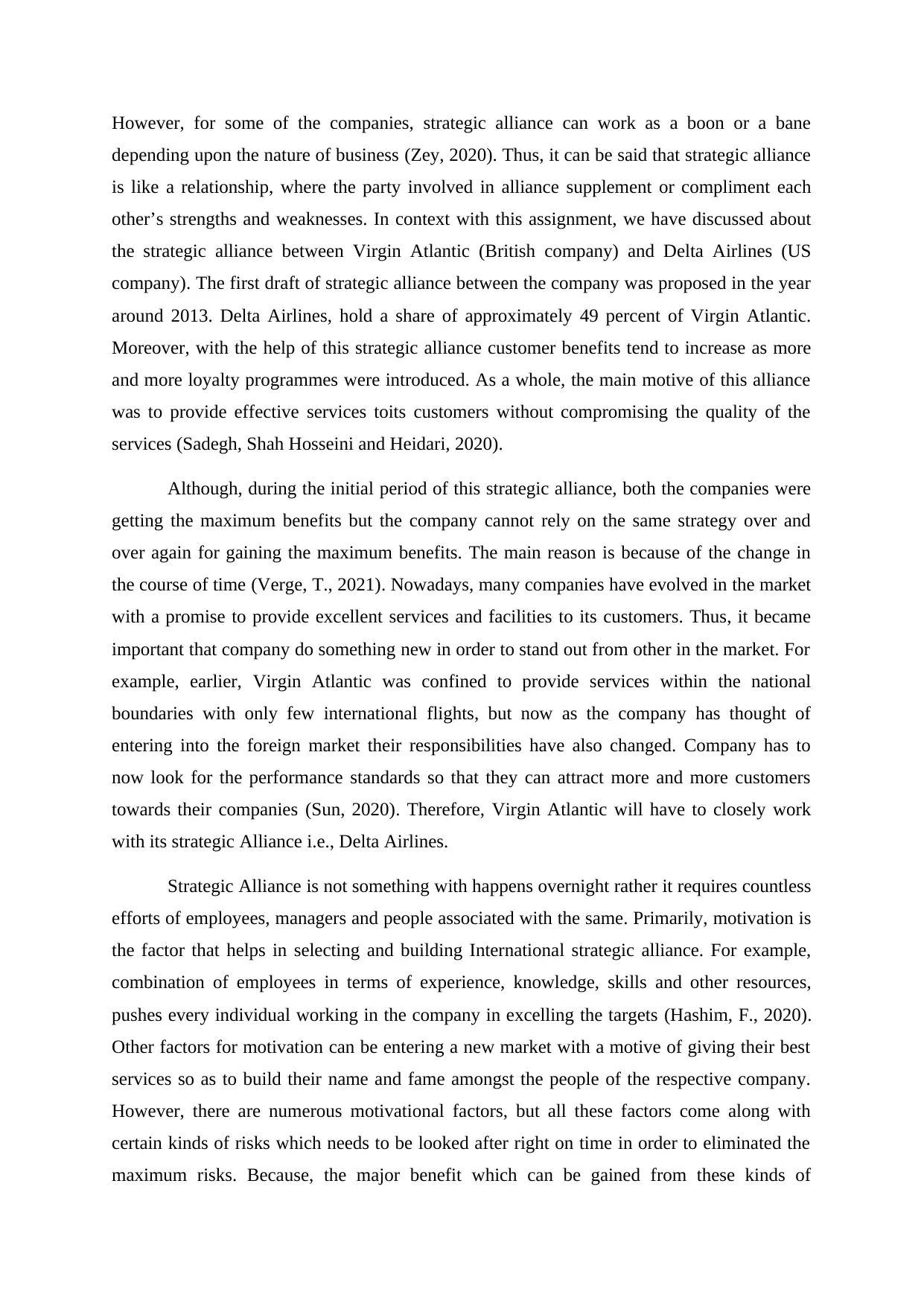
However, for some of the companies, strategic alliance can work as a boon or a bane
depending upon the nature of business (Zey, 2020). Thus, it can be said that strategic alliance
is like a relationship, where the party involved in alliance supplement or compliment each
other’s strengths and weaknesses. In context with this assignment, we have discussed about
the strategic alliance between Virgin Atlantic (British company) and Delta Airlines (US
company). The first draft of strategic alliance between the company was proposed in the year
around 2013. Delta Airlines, hold a share of approximately 49 percent of Virgin Atlantic.
Moreover, with the help of this strategic alliance customer benefits tend to increase as more
and more loyalty programmes were introduced. As a whole, the main motive of this alliance
was to provide effective services toits customers without compromising the quality of the
services (Sadegh, Shah Hosseini and Heidari, 2020).
Although, during the initial period of this strategic alliance, both the companies were
getting the maximum benefits but the company cannot rely on the same strategy over and
over again for gaining the maximum benefits. The main reason is because of the change in
the course of time (Verge, T., 2021). Nowadays, many companies have evolved in the market
with a promise to provide excellent services and facilities to its customers. Thus, it became
important that company do something new in order to stand out from other in the market. For
example, earlier, Virgin Atlantic was confined to provide services within the national
boundaries with only few international flights, but now as the company has thought of
entering into the foreign market their responsibilities have also changed. Company has to
now look for the performance standards so that they can attract more and more customers
towards their companies (Sun, 2020). Therefore, Virgin Atlantic will have to closely work
with its strategic Alliance i.e., Delta Airlines.
Strategic Alliance is not something with happens overnight rather it requires countless
efforts of employees, managers and people associated with the same. Primarily, motivation is
the factor that helps in selecting and building International strategic alliance. For example,
combination of employees in terms of experience, knowledge, skills and other resources,
pushes every individual working in the company in excelling the targets (Hashim, F., 2020).
Other factors for motivation can be entering a new market with a motive of giving their best
services so as to build their name and fame amongst the people of the respective company.
However, there are numerous motivational factors, but all these factors come along with
certain kinds of risks which needs to be looked after right on time in order to eliminated the
maximum risks. Because, the major benefit which can be gained from these kinds of
depending upon the nature of business (Zey, 2020). Thus, it can be said that strategic alliance
is like a relationship, where the party involved in alliance supplement or compliment each
other’s strengths and weaknesses. In context with this assignment, we have discussed about
the strategic alliance between Virgin Atlantic (British company) and Delta Airlines (US
company). The first draft of strategic alliance between the company was proposed in the year
around 2013. Delta Airlines, hold a share of approximately 49 percent of Virgin Atlantic.
Moreover, with the help of this strategic alliance customer benefits tend to increase as more
and more loyalty programmes were introduced. As a whole, the main motive of this alliance
was to provide effective services toits customers without compromising the quality of the
services (Sadegh, Shah Hosseini and Heidari, 2020).
Although, during the initial period of this strategic alliance, both the companies were
getting the maximum benefits but the company cannot rely on the same strategy over and
over again for gaining the maximum benefits. The main reason is because of the change in
the course of time (Verge, T., 2021). Nowadays, many companies have evolved in the market
with a promise to provide excellent services and facilities to its customers. Thus, it became
important that company do something new in order to stand out from other in the market. For
example, earlier, Virgin Atlantic was confined to provide services within the national
boundaries with only few international flights, but now as the company has thought of
entering into the foreign market their responsibilities have also changed. Company has to
now look for the performance standards so that they can attract more and more customers
towards their companies (Sun, 2020). Therefore, Virgin Atlantic will have to closely work
with its strategic Alliance i.e., Delta Airlines.
Strategic Alliance is not something with happens overnight rather it requires countless
efforts of employees, managers and people associated with the same. Primarily, motivation is
the factor that helps in selecting and building International strategic alliance. For example,
combination of employees in terms of experience, knowledge, skills and other resources,
pushes every individual working in the company in excelling the targets (Hashim, F., 2020).
Other factors for motivation can be entering a new market with a motive of giving their best
services so as to build their name and fame amongst the people of the respective company.
However, there are numerous motivational factors, but all these factors come along with
certain kinds of risks which needs to be looked after right on time in order to eliminated the
maximum risks. Because, the major benefit which can be gained from these kinds of
Paraphrase This Document
Need a fresh take? Get an instant paraphrase of this document with our AI Paraphraser
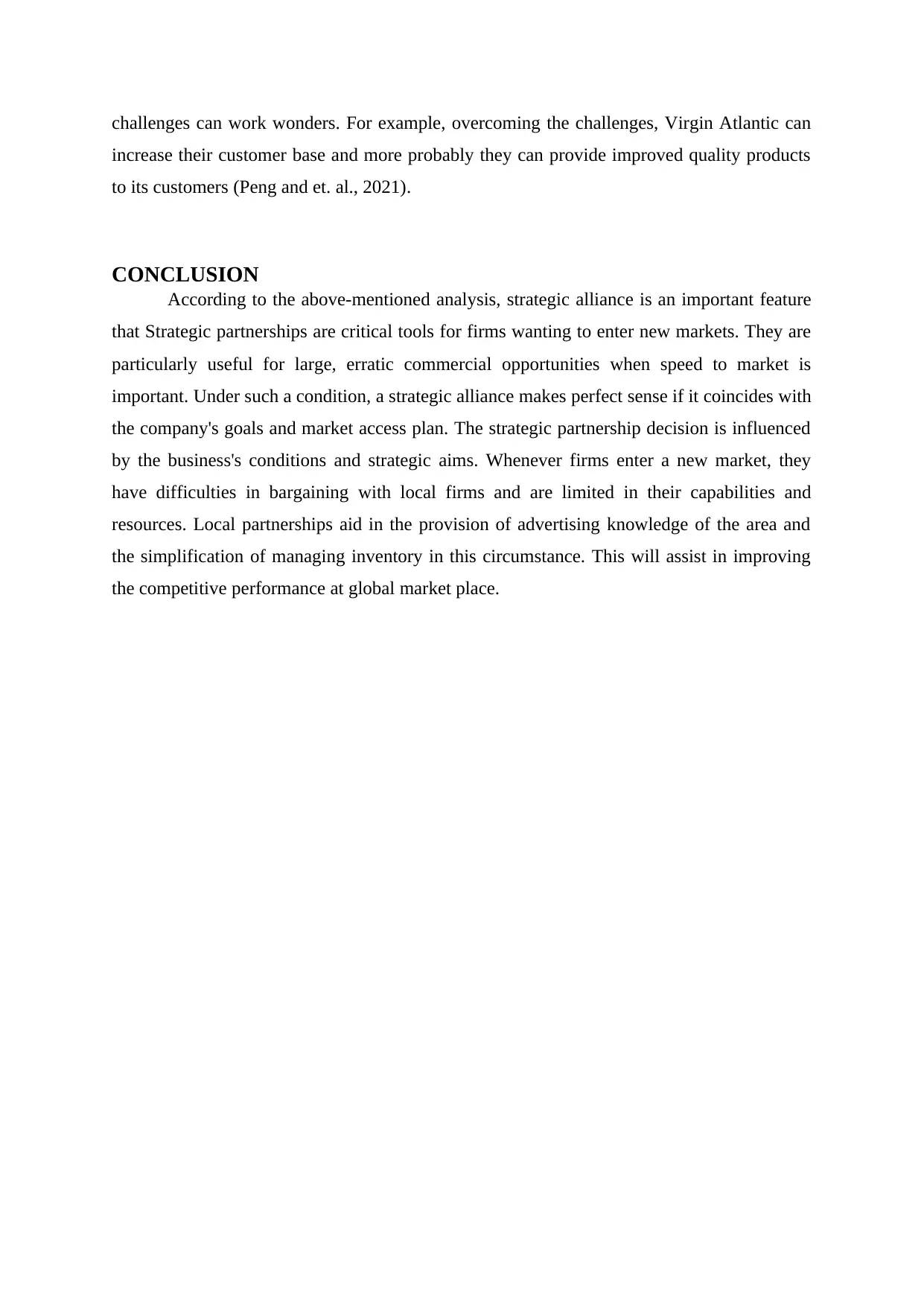
challenges can work wonders. For example, overcoming the challenges, Virgin Atlantic can
increase their customer base and more probably they can provide improved quality products
to its customers (Peng and et. al., 2021).
CONCLUSION
According to the above-mentioned analysis, strategic alliance is an important feature
that Strategic partnerships are critical tools for firms wanting to enter new markets. They are
particularly useful for large, erratic commercial opportunities when speed to market is
important. Under such a condition, a strategic alliance makes perfect sense if it coincides with
the company's goals and market access plan. The strategic partnership decision is influenced
by the business's conditions and strategic aims. Whenever firms enter a new market, they
have difficulties in bargaining with local firms and are limited in their capabilities and
resources. Local partnerships aid in the provision of advertising knowledge of the area and
the simplification of managing inventory in this circumstance. This will assist in improving
the competitive performance at global market place.
increase their customer base and more probably they can provide improved quality products
to its customers (Peng and et. al., 2021).
CONCLUSION
According to the above-mentioned analysis, strategic alliance is an important feature
that Strategic partnerships are critical tools for firms wanting to enter new markets. They are
particularly useful for large, erratic commercial opportunities when speed to market is
important. Under such a condition, a strategic alliance makes perfect sense if it coincides with
the company's goals and market access plan. The strategic partnership decision is influenced
by the business's conditions and strategic aims. Whenever firms enter a new market, they
have difficulties in bargaining with local firms and are limited in their capabilities and
resources. Local partnerships aid in the provision of advertising knowledge of the area and
the simplification of managing inventory in this circumstance. This will assist in improving
the competitive performance at global market place.
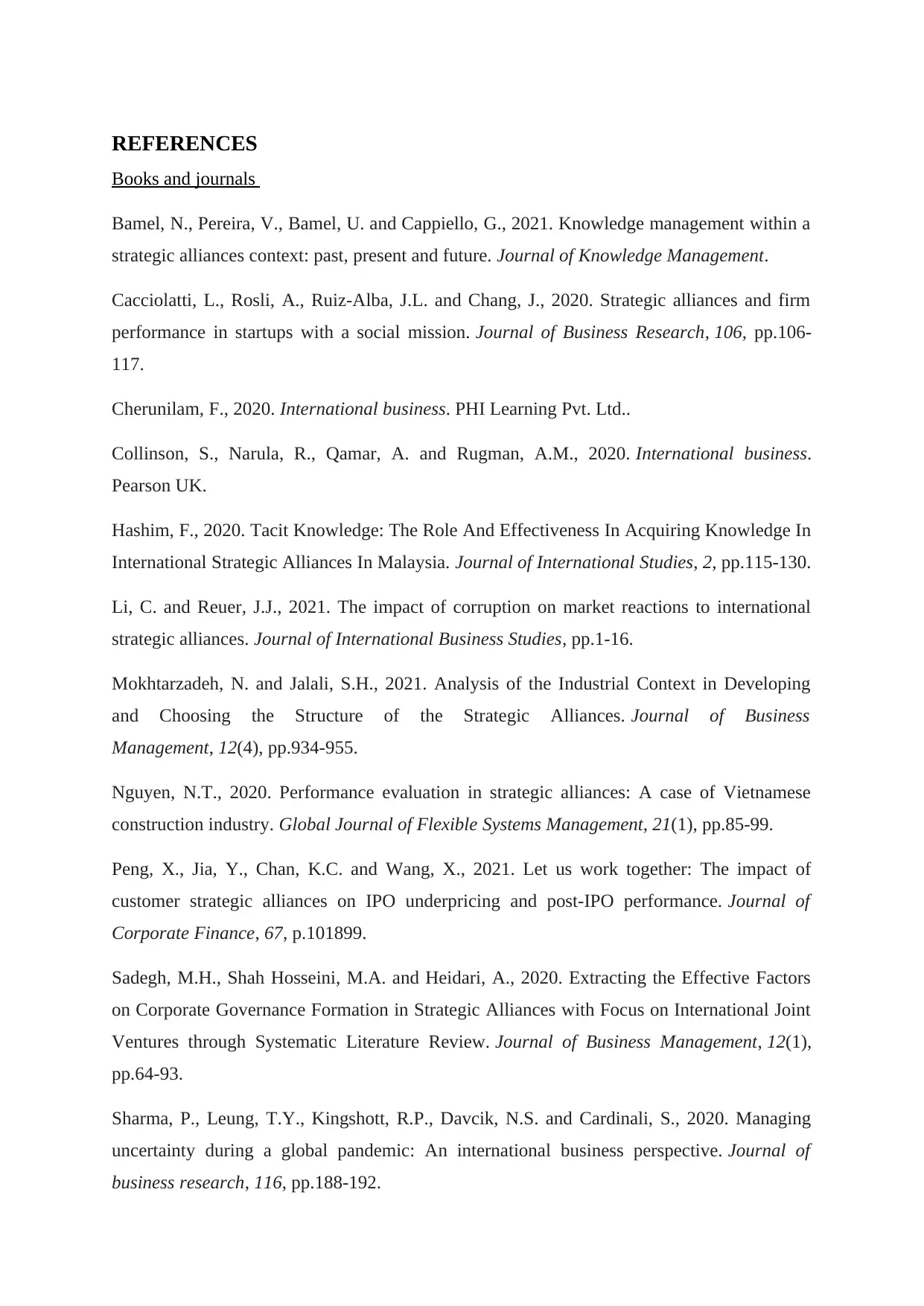
REFERENCES
Books and journals
Bamel, N., Pereira, V., Bamel, U. and Cappiello, G., 2021. Knowledge management within a
strategic alliances context: past, present and future. Journal of Knowledge Management.
Cacciolatti, L., Rosli, A., Ruiz-Alba, J.L. and Chang, J., 2020. Strategic alliances and firm
performance in startups with a social mission. Journal of Business Research, 106, pp.106-
117.
Cherunilam, F., 2020. International business. PHI Learning Pvt. Ltd..
Collinson, S., Narula, R., Qamar, A. and Rugman, A.M., 2020. International business.
Pearson UK.
Hashim, F., 2020. Tacit Knowledge: The Role And Effectiveness In Acquiring Knowledge In
International Strategic Alliances In Malaysia. Journal of International Studies, 2, pp.115-130.
Li, C. and Reuer, J.J., 2021. The impact of corruption on market reactions to international
strategic alliances. Journal of International Business Studies, pp.1-16.
Mokhtarzadeh, N. and Jalali, S.H., 2021. Analysis of the Industrial Context in Developing
and Choosing the Structure of the Strategic Alliances. Journal of Business
Management, 12(4), pp.934-955.
Nguyen, N.T., 2020. Performance evaluation in strategic alliances: A case of Vietnamese
construction industry. Global Journal of Flexible Systems Management, 21(1), pp.85-99.
Peng, X., Jia, Y., Chan, K.C. and Wang, X., 2021. Let us work together: The impact of
customer strategic alliances on IPO underpricing and post-IPO performance. Journal of
Corporate Finance, 67, p.101899.
Sadegh, M.H., Shah Hosseini, M.A. and Heidari, A., 2020. Extracting the Effective Factors
on Corporate Governance Formation in Strategic Alliances with Focus on International Joint
Ventures through Systematic Literature Review. Journal of Business Management, 12(1),
pp.64-93.
Sharma, P., Leung, T.Y., Kingshott, R.P., Davcik, N.S. and Cardinali, S., 2020. Managing
uncertainty during a global pandemic: An international business perspective. Journal of
business research, 116, pp.188-192.
Books and journals
Bamel, N., Pereira, V., Bamel, U. and Cappiello, G., 2021. Knowledge management within a
strategic alliances context: past, present and future. Journal of Knowledge Management.
Cacciolatti, L., Rosli, A., Ruiz-Alba, J.L. and Chang, J., 2020. Strategic alliances and firm
performance in startups with a social mission. Journal of Business Research, 106, pp.106-
117.
Cherunilam, F., 2020. International business. PHI Learning Pvt. Ltd..
Collinson, S., Narula, R., Qamar, A. and Rugman, A.M., 2020. International business.
Pearson UK.
Hashim, F., 2020. Tacit Knowledge: The Role And Effectiveness In Acquiring Knowledge In
International Strategic Alliances In Malaysia. Journal of International Studies, 2, pp.115-130.
Li, C. and Reuer, J.J., 2021. The impact of corruption on market reactions to international
strategic alliances. Journal of International Business Studies, pp.1-16.
Mokhtarzadeh, N. and Jalali, S.H., 2021. Analysis of the Industrial Context in Developing
and Choosing the Structure of the Strategic Alliances. Journal of Business
Management, 12(4), pp.934-955.
Nguyen, N.T., 2020. Performance evaluation in strategic alliances: A case of Vietnamese
construction industry. Global Journal of Flexible Systems Management, 21(1), pp.85-99.
Peng, X., Jia, Y., Chan, K.C. and Wang, X., 2021. Let us work together: The impact of
customer strategic alliances on IPO underpricing and post-IPO performance. Journal of
Corporate Finance, 67, p.101899.
Sadegh, M.H., Shah Hosseini, M.A. and Heidari, A., 2020. Extracting the Effective Factors
on Corporate Governance Formation in Strategic Alliances with Focus on International Joint
Ventures through Systematic Literature Review. Journal of Business Management, 12(1),
pp.64-93.
Sharma, P., Leung, T.Y., Kingshott, R.P., Davcik, N.S. and Cardinali, S., 2020. Managing
uncertainty during a global pandemic: An international business perspective. Journal of
business research, 116, pp.188-192.
⊘ This is a preview!⊘
Do you want full access?
Subscribe today to unlock all pages.

Trusted by 1+ million students worldwide
1 out of 13
Related Documents
Your All-in-One AI-Powered Toolkit for Academic Success.
+13062052269
info@desklib.com
Available 24*7 on WhatsApp / Email
![[object Object]](/_next/static/media/star-bottom.7253800d.svg)
Unlock your academic potential
Copyright © 2020–2025 A2Z Services. All Rights Reserved. Developed and managed by ZUCOL.





